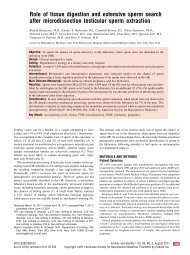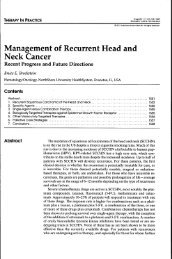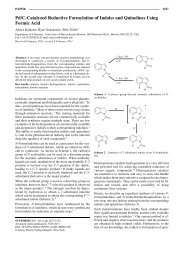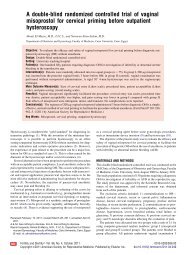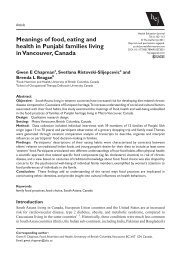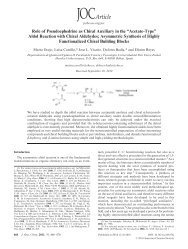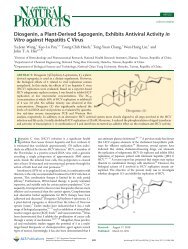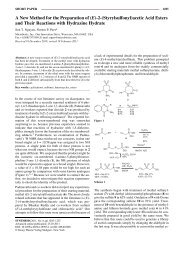Development of a Depth-Integrated Sample Arm to Reduce Solids ...
Development of a Depth-Integrated Sample Arm to Reduce Solids ...
Development of a Depth-Integrated Sample Arm to Reduce Solids ...
You also want an ePaper? Increase the reach of your titles
YUMPU automatically turns print PDFs into web optimized ePapers that Google loves.
Thus, the mo<strong>to</strong>rized ram rotates the sample arm assembly <strong>to</strong> any<br />
vertical depth within the s<strong>to</strong>rm sewer. Once the PLC determines<br />
that the potentiometer has reached the target voltage, it triggers<br />
the au<strong>to</strong>sampler <strong>to</strong> operate with normal purge/withdraw cycles <strong>to</strong><br />
collect a s<strong>to</strong>rmwater quality sample and deposit it in one or more<br />
s<strong>to</strong>rage containers. Once the sample has been acquired, the DISA<br />
either moves <strong>to</strong> a new position for collection <strong>of</strong> another sample or<br />
fully retracts <strong>to</strong> the horizontal position, whi6h removes the DISA<br />
from the flow path with any debris that may have accumulated on<br />
the sample arm assembly while acquiring a sample.<br />
Method <strong>to</strong> Compare the <strong>Depth</strong>-<strong>Integrated</strong> <strong>Sample</strong> <strong>Arm</strong> with<br />
a Fixed-Point Au<strong>to</strong>sampler Configuration. This study involved<br />
collection and chaiacterization <strong>of</strong> data derived from<br />
s<strong>to</strong>rmwater quality samples collected in two urban drainage areas<br />
located in Madison, Wisconsin. The first was a 2.4-ha (6-ac)<br />
commercial parking area adjacent <strong>to</strong> a shopping center complex;<br />
the second was a 21-ha (53-ac) single-family residential area..<br />
Run<strong>of</strong>f was collected in multiple s<strong>to</strong>rm sewer inlets at each site<br />
and then was conveyed through a single, circular, concrete pipe<br />
with diameters <strong>of</strong> approximately 91 and 107 cm (36 and 42 in.) at<br />
the parking lot and residential drainage areas, respectively.<br />
Each moni<strong>to</strong>ring station was equipped with two au<strong>to</strong>mated<br />
water quality samplers and instruments <strong>to</strong> measure water level and<br />
velocity. Measurement, control, and s<strong>to</strong>rage <strong>of</strong> data were<br />
performed by electronic data loggers. <strong>Sample</strong> collection was<br />
activated by a rise in water level in the pipe during'a s<strong>to</strong>rm. Once<br />
the water level threshold was exceeded, typically a depth <strong>of</strong><br />
approximately 0.06 m (0.2 ft) from the pipe floor, each au<strong>to</strong>mated<br />
water quality sampler collected a discrete water sample in<strong>to</strong> I-L<br />
plastic containers. This process was repeated for every approximately<br />
0.03-m (0.1-ft) increase and approximately 0.06-m (0.2-ft)<br />
,decrease in water level over the duration <strong>of</strong> the s<strong>to</strong>rm hydrograph<br />
until the water in the pipe receded below the water level threshold.<br />
Each au<strong>to</strong>sampler was located side-by-side in an aluminum<br />
shelter directly over the s<strong>to</strong>rm sewer. ISCO 3700 pump heads with<br />
a 24-bottle configuration were used <strong>to</strong> provide consistent intake<br />
velocities. Pump heads were programmed with similar purge/<br />
withdraw cycles <strong>to</strong> flush the sample tubing before sample<br />
collection. One au<strong>to</strong>sampler collected a water quality sample<br />
from a fixed point located approximately 2.5 cm (1 in.) <strong>of</strong>f the<br />
pipe invert (herein called the fixed-point sampler), and the other<br />
collected a sample from multiple points using the DISA. Upon<br />
sample initiation, each sampler would collect a series <strong>of</strong> three<br />
successive sub-samples separated 'by 1-minute increments.<br />
Because the fixed-point sampler's intake nozzle was secured <strong>to</strong><br />
the pipe floor, each sub-sample was taken from the same location.<br />
The DISA was programmed <strong>to</strong> collect each sub-sample from<br />
different vertical locations in the water column. The first subsample<br />
was collected approximately 2.5 cm (I in.) from the.pipe<br />
invert <strong>to</strong> coincide with the intake location <strong>of</strong> the fixed-point<br />
sampler. The DISA then would relocate the intake nozzle <strong>to</strong> a<br />
vertical point approximating 30 and 60% <strong>of</strong> the water level for the<br />
second and third sub-samples, respectively. In doing so, subsamples<br />
were collected from the lower, middle, and upper onethird<br />
<strong>of</strong> the full water column. For example, if the water level was<br />
0.3 m.(1.0 ft), the first, second, and third sub-samples (herein<br />
called the lower, middle, and upper sub-samples) would be<br />
collected at a depth <strong>of</strong> 0.02, 0.09, and 0.2 m (0.08, 0.3, and 0.6 ft)<br />
"from the pipe invert, respectively. Although the vertical spacing <strong>of</strong><br />
each sub-sample remained consistent for this study, the location <strong>of</strong><br />
April 2011<br />
Selbig and Bannerman<br />
the nozzle intake can be programmed <strong>to</strong> accommodate any<br />
vertical position in the pipe, from completely vertical <strong>to</strong><br />
completely horizontal.<br />
Upon run<strong>of</strong>f cessation, water quality samples were retrieved<br />
and transported <strong>to</strong> the U.S Geological Survey Middle<strong>to</strong>n Field<br />
Office in Middle<strong>to</strong>n, Wisconsin. Each discrete sample was split<br />
equally in<strong>to</strong> two labora<strong>to</strong>ry-prepared containers by passing the 1 L<br />
sample through a cone splitter. Approximately 180 mL also was<br />
transferred from the cone splitter in<strong>to</strong> a separa<strong>to</strong>ry funnel for<br />
determination <strong>of</strong> PSD. Except for the separa<strong>to</strong>ry funnel, processed<br />
samples were chilled on ice and delivered <strong>to</strong> the Wisconsin State<br />
Labora<strong>to</strong>ry <strong>of</strong> Hygiene (Madison, Wisconsin) for analysis <strong>of</strong> <strong>to</strong>tal<br />
suspended solids (TSS), <strong>to</strong>tal volatile suspended solids (TVSS),<br />
and suspended sediment.<br />
Particle Size Distribution Measurement. The PSD.<strong>of</strong> run<strong>of</strong>f<br />
samples was measured using a Laser In-Situ Scattering and<br />
Transmissometry (LISST) particle size analyzer (Sequoia Scientific,<br />
Bellevue, Washing<strong>to</strong>n). The LISST-Portable uses laser<br />
diffraction <strong>to</strong> measure PSD as particle volume concentration<br />
(microliters per liter) in 32 logarithmically spaced bins ranging in<br />
size from approximately 2 <strong>to</strong> 350 gtm. Additional details are<br />
described in Agrawal and Pottsmith (2000). Contents <strong>of</strong> the<br />
separa<strong>to</strong>ry funnel were transferred in<strong>to</strong> the holding chamber <strong>of</strong> the<br />
LISST-Portable. Use <strong>of</strong> a separa<strong>to</strong>ry funnel allowed for complete<br />
transfer <strong>of</strong> the sample without the potential <strong>to</strong> bias coarse particle<br />
concentration by pouring or pipetting.<br />
The upper particle size fraction reported by the LISST-Portable<br />
was approximately 350 gim. Although the particle size fraction in<br />
the majority <strong>of</strong> samples collected as part <strong>of</strong> this study was below<br />
this reporting limit, ,some samples contained particles exceeding<br />
that size (



